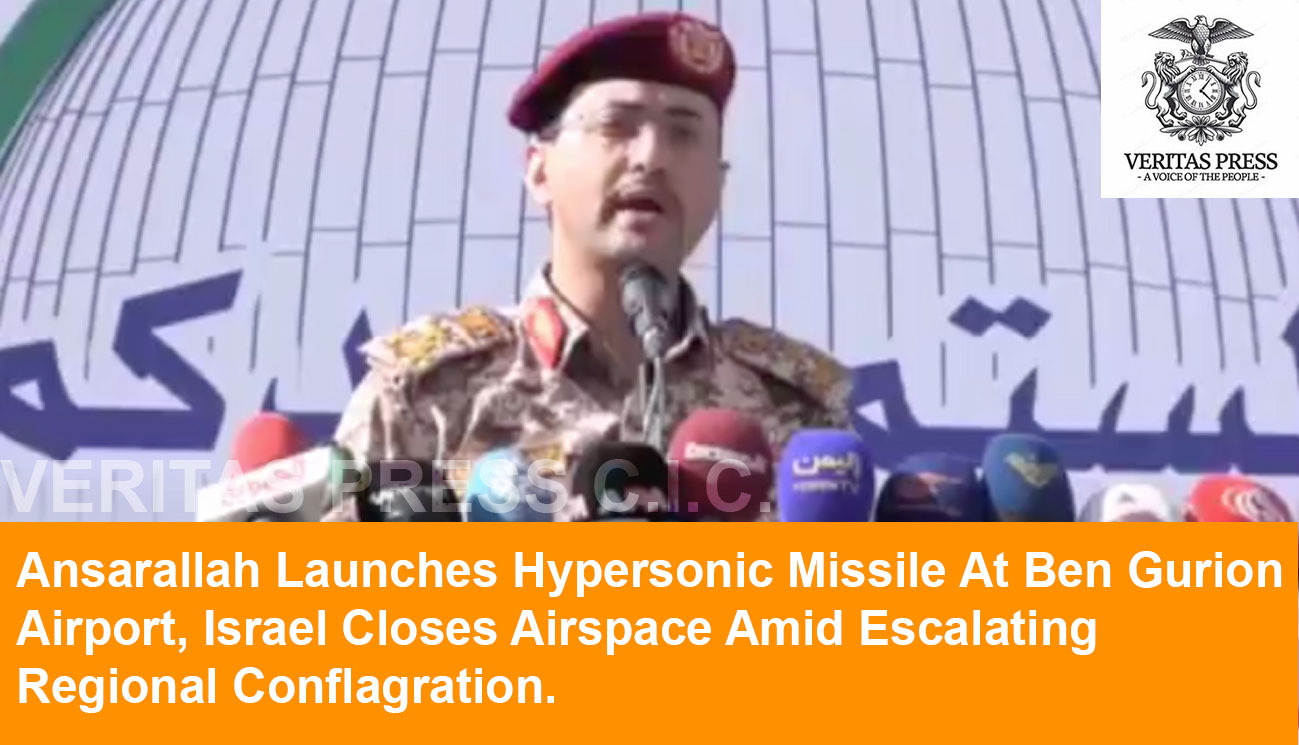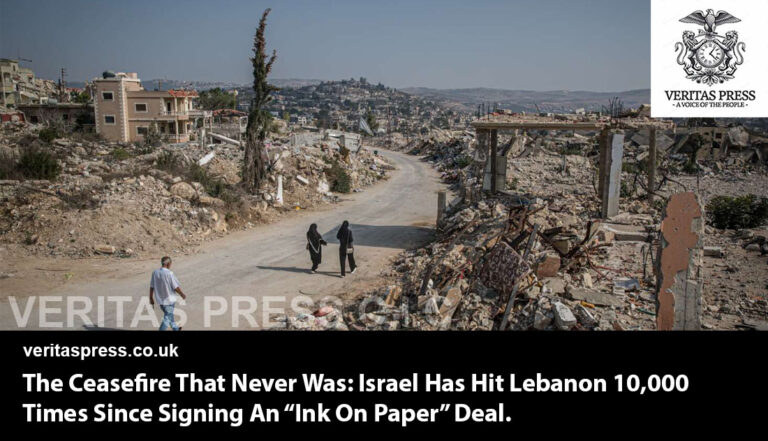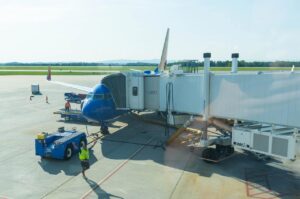In a dramatic escalation of cross-border hostilities, Yemen’s Ansarallah movement (commonly known as the Houthis) announced on Tuesday that it had launched a hypersonic ballistic missile targeting Ben Gurion Airport in Tel Aviv. The operation, described by Houthi military spokesperson Brigadier General Yahya Saree as a “qualitative military strike,” reportedly succeeded in disrupting air traffic and forcing millions of Israelis into bomb shelters.
According to Saree, the missile used in the strike was a newly unveiled “Palestine-2” hypersonic ballistic missile, part of an expanding arsenal that the Houthis say is being deployed in retaliation for Israeli attacks on Yemen and in solidarity with Palestinians in Gaza.
“The missile forces of Yemen’s armed forces executed a unique and special military operation using a Palestine-2 hypersonic ballistic missile targeting Lod Airport [Ben Gurion Airport],” Saree declared in a televised address on the Houthi-run Al Masirah channel. “The operation achieved its objective successfully, halting airport operations and forcing millions of Zionists to seek shelter.”
Israel Closes Airspace After Missile Launch:
In response, Israel’s Channel 2 and other media outlets reported that Israeli airspace was temporarily closed following the missile launch from Yemen. Air raid sirens blared across central Israel in the early hours of Tuesday morning, and Ben Gurion Airport was briefly shut down amid fears of further strikes.
The Israel Defence Forces (IDF) later claimed that the missile was intercepted mid-flight, though the extent of damage, if any, remains contested. Israeli authorities have not provided independent verification of whether the missile struck near or inside the airport perimeter.
Despite Israeli interceptions, the psychological impact of the attack, including mass panic, flight cancellations, and shelter-in-place orders, was significant.
Expanding Theatre: Drones, Hypersonic, and Retaliatory Strikes
This latest strike is part of an intensifying cycle of attacks between Israel and Ansarallah. On Monday, Houthi forces claimed responsibility for coordinated drone attacks on five Israeli targets, including:
- Ben Gurion Airport
- Ramon Airport
- The port of Eilat
- Undisclosed military sites
In retaliation, the Israeli Air Force launched a series of airstrikes on Yemen’s western Red Sea port of Hodeidah, a key logistical hub for the Houthis. The IDF said the strikes targeted infrastructure used to repair and rearm missile and drone systems, including fuel tankers, engineering vehicles, and ships allegedly involved in Houthi maritime operations.
A pier at the Hodeidah port was reportedly destroyed, according to AFP, citing a Houthi spokesperson.
Israeli Defence Minister Yoav Gallant warned that Israel would pursue an aggressive strategy to “neutralise” the Houthi threat and prevent the group from rebuilding its operational capacity.
“Yemen, like Iran, will pay a heavy price for attacking the State of Israel,” Gallant said. “We will not tolerate ongoing missile and drone threats from hostile actors aligned with Tehran.”
Hypersonic Capabilities And Strategic Implications:
The introduction of the “Palestine-2” hypersonic ballistic missile marks a concerning development for Israeli defence planners. Hypersonic missiles, capable of speeds exceeding Mach 5, pose a significant challenge to existing missile defence systems due to their speed, manoeuvrability, and low detection time.
While Israel’s Iron Dome and David’s Sling systems have demonstrated high interception rates against conventional and cruise missiles, the ability to reliably counter hypersonic threats remains in question.
The Houthis’ capacity to manufacture or acquire such weapons, whether indigenously or via Iranian assistance, has raised alarm bells in Tel Aviv, Washington, and Riyadh.
According to military analysts, the Palestine-2 missile may share technological origins with Iranian hypersonic systems, such as the “Fattah” missile unveiled by Tehran in 2023. If confirmed, this would signal a deeper level of coordination between the Houthis and Iran’s Revolutionary Guard Corps (IRGC).
Gaza, Regional Solidarity, And Escalating War:
Ansarallah has repeatedly declared that its strikes on Israel are carried out in solidarity with Palestinians amid Israel’s ongoing assault on Gaza, now in its tenth month. Since October 7, 2023, Israeli bombardments and ground operations have killed or wounded over 377,000 Palestinians, according to Gaza health officials and aid agencies. The vast majority of casualties are women and children, with over 10,000 still missing under the rubble.
Entire neighbourhoods have been razed, famine is widespread, and hospitals have ceased functioning amid relentless airstrikes. Human rights groups and UN officials have accused Israel of engaging in collective punishment, war crimes, and genocidal practices.
“Our military operations will continue until the aggression on Gaza ends and the siege is lifted,” Saree reaffirmed. “We are part of a regional resistance axis standing with the oppressed Palestinian people.”
In addition to missile and drone attacks on Israeli territory, the Houthis have expanded their campaign to maritime routes. Since late 2023, they have targeted Israeli-linked vessels in the Red Sea and declared a naval blockade of the ports of Eilat and Haifa. They have also issued warnings to foreign airlines operating flights into Israeli airspace, declaring Ben Gurion Airport a military target.
Strategic Fallout And Regional Calculations:
The expanding conflict has drawn in multiple fronts, from Lebanon’s Hezbollah in the north to Iraqi militias and now the Houthis in Yemen, complicating Israel’s military calculus and threatening to spiral into a wider regional war.
The United States has continued to provide Israel with diplomatic cover and military support, but Washington’s own forces have come under threat in the Red Sea, leading to sporadic engagements with Houthi missiles and drones.
While Israel insists it retains full air superiority and the capacity to retaliate against “any threat from the region,” the increasing reach and precision of Houthi missile capabilities suggest a shifting strategic balance.
As Tel Aviv braces for potential future attacks and regional actors rally in opposition to Israel’s war on Gaza, the risk of multi-front escalation looms larger than ever.
Conclusion: A Regional Powder Keg, Fuelled By Impunity And Collapsing Deterrence.
The hypersonic missile strike on Ben Gurion Airport marks a chilling turning point, not just in the ongoing confrontation between Israel and Yemen’s Ansarallah movement, but in the wider regional landscape. What was once a symbolic display of “solidarity strikes” has now developed into a sophisticated, coordinated campaign of military disruption, targeting the very core of Israel’s civilian and strategic infrastructure.
This escalation raises serious questions about the effectiveness of Israel’s highly-touted missile defence system. If a hypersonic missile, allegedly Iranian in origin, can travel over 2,000 kilometres from Yemen and compel Israel to shut down its main international airport, then the myth of absolute security supporting Israel’s regional deterrence is beginning to crack. While the IDF claims interception, the psychological and operational consequences are unavoidable.
Equally troubling is Israel’s pattern of response: disproportionate airstrikes on civilian infrastructure in Yemen, fuel depots, engineering vehicles, and port piers, under the pretext of “prevention.” These attacks mirror the same scorched-earth tactics employed in Gaza, and reflect a deeper strategic doctrine of collective punishment that is now being exported across the region. The bombing of Hodeidah port, a lifeline for millions of Yemenis already suffering under blockade and famine, represents not just military retaliation, but a clear violation of international humanitarian law.
Meanwhile, global powers, chief among them the United States, continue to offer tacit or overt support to Israel, providing cover for these escalations while failing to reckon with the long-term consequences. The Biden and Trump administrations alike have branded the Houthis as Iranian proxies, while ignoring the political reality: Ansarallah’s attacks, however controversial or militarily provocative, are rooted in a growing regional consensus that Israel’s war on Gaza must be answered. The longer Israel’s impunity persists in Gaza, the more legitimacy such resistance operations gain among Arab populations, even as their governments remain complicit or silent.
The strike on Ben Gurion is not an isolated incident; it is a warning shot from a fractured region where decades of Western-backed impunity, occupation, and militarism are beginning to backfire. If Israel and its allies continue to dismiss these attacks as rogue outbursts instead of reckoning with their root causes, genocide in Gaza, apartheid in the occupied territories, and endless war-making, then this crisis will only deepen.
What we are witnessing is not the containment of a proxy conflict. It is the erosion of deterrence, the collapse of diplomacy, and the slow ignition of a regional war that no missile shield can stop.
Advertisements
Tags:






























Leave a Reply